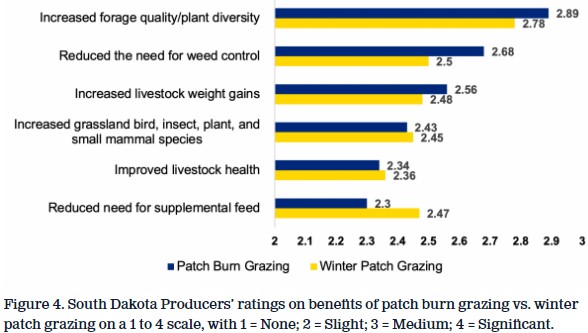By Tong Wang and Kenneth C. Olson et.al
Many bird species within the Western Great Plains require landscapes containing a mosaic of undisturbed grass and heavily disturbed grass (Knopf, 1996). Traditional rangeland management promotes uniform forage utilization yet causes detrimental effects on the richness of plant species and wildlife habitat structure when used on a large scale (Derner et al., 2009). Therefore, management practices that increase heterogeneity in vegetation structure and composition play an important role in developing diverse habitat types and preserving grassland wildlife species.
Heterogeneous Rangeland Management Practice
Patch burn grazing (PBG) is a rangeland management practice that aims to develop grass heterogeneity (Fuhlendorf et al., 2006). PBG burns a different section of the landscape every year so that cattle selectively graze recently burned portions of a pasture, allowing grass in unburned or previously burned sections to recover. Although PBG increases grass composition and structure in a way that benefits wildlife and maintains livestock production, it also requires additional labor and equipment and carries the risks of legal liability and short-term forage shortage (Kreuter et al., 2008). Therefore, many rangeland managers in the semiarid regions show strong aversion to PBG.
Winter patch grazing (WPG) is a non-burn heterogeneous management approach that utilizes livestock grazing as a tool to create heavily grazed patches to mimic the effect of fire. WPG involves heavy grazing on a different section of the landscape every year in winter when vegetation is dormant. In comparison to PBG, WPG creates the desirable grassland heterogeneity through grazing and therefore could be more readily adopted by landowners and managers.
To understand South Dakota (SD) producers’ attitudes towards PBG and WPG, we conducted an online survey among agricultural producers on email lists of South Dakota State University Extension specialists. We administered the survey through the online survey tool QuestionPro between November 2019 and January 2020 and received 91 completed responses.
Potential Challenges of PBG and WPG Adoption
We asked producers to rate the potential challenges of PBG and WPG on a 1 to 5 scale, with 1 = Not a Challenge; 2 = Minor Challenge; 3 = Some Challenge; 4 = Quite a Challenge; 5 = Great Challenge. Figure 1 demonstrates average ratings on different challenges associated with PBG adoption, using survey data provided by producers in SD. Among the six possible challenges, the top two were 1) increased liability when fire gets out of control and 2) weather/climate factors such as wind and drought. Both factors had average ratings greater than 4 (‘quite a challenge’) and were closely related to fire risks. On the county level, producers in most western SD counties, where drought is more frequent, viewed PBG-related fire liability as a great challenge, whereas producers in eastern SD counties generally showed less concern towards the fire risk related to PBG (Figure 2).
Compared to PBG, producers generally viewed WPG adoption as less challenging, with the two top barriers being winter shelter and water source constraints during the WPG period. This finding indicates that in semiarid areas of South Dakota where fire can more easily get out of control, producers generally regard WPG as a more practical method to increase grass heterogeneity.
Potential Benefits of PBG and WPG Adoption
We also asked producers about the expected benefits associated with PBG and WPG on their ranch. They rated the expected benefits on a scale of one to four, 1 = ‘None’; 2 = ‘Slight’; 3 = ‘Medium’; 4 = ‘Significant’. On average, producers rated the benefits generated from PBG and WPG adoption as somewhere between slight and medium (Figure 4). In terms of increased forage quality and plant diversity, reduced weed control needs, and increased livestock weight gains, producers perceived that PBG would be more beneficial than WPG; whereas regarding increased grassland wildlife species, improved livestock health and reduced need for supplemental feed, WPG was expected to have greater benefits than PBG.

In summary, we found that producers in SD found WPG adoption less challenging than PBG but could generate a number of benefits equivalent to PBG. This implies that with proper guidance, WPG could be adopted as an efficient tool to preserve grassland wildlife species while maintaining rangeland profitability.
Source : sdstate.edu